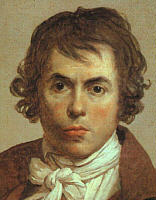
|
He was never a good student in school- in his own words, "I was always hiding behind the instructors chair, drawing for the duration of the class".
When David was 16 he began studying art at the Académie Royale under the rococo painter J.
M. Vien. After many unsuccessful attempts, he finally won the Prix de Rome in 1774, and on the
ensuing trip to Italy he was strongly influenced by classical art and by the classically inspired
work of the 17th-century painter Nicolas Poussin. David quickly evolved his own individual
neoclassical style, drawing subject matter from ancient sources and basing form and gesture on
Roman sculpture. His famous "Oath of the Horatii" was consciously intended as a proclamation of the new neoclassical style in which dramatic lighting, ideal forms, and gestural clarity are
emphasized. Presenting a lofty moralistic (and by implication patriotic) theme, the work became
the principal model for noble and heroic historical painting of the next two decades. It also
launched his popularity and awarded him the right to take on his own students.
After 1789, David adopted a realistic rather than neoclassical painting style in order to record
scenes of the French Revolution (1789-1799). David was very active in the Revolution, being
elected a deputy to the National Convention on September 17, 1792. He took his place with the
extremists known as the Montagnards- along with Marat, Danton, and Robespierre.
During this time he had produced deeds both positive and negative: On the positive side he
proposed the establishment of an inventory of all national treasures- making him one of the
founders of France's museums. In fact, he played an active role in the organization of the future
Louvre, Paris.
On the negative side, his radicalism during the Revolution bred within him a certain madness.
He was appointed to the Committee of General Security in 1793- which gave him the power to
sign nearly 300 arrested individuals to be guillotined. After the end of the Revolution,
imprisoned because of his actions during the Reign of Terror, he wrote a letter to a friend
stating, "I believed, in accepting the post of legislator- an honorable post, but one very difficult
to fulfill- that an upright heart would suffice, but I was lacking in the second quality, by which
mean insight." A delegation of his students demanded his release, and he was freed on December 28, 1794.
Near the end of 1797 he met Napoleon Bonaparte. From 1799 to 1815 he was Napoleon's official
painter, chronicling the reign of Napoleon I in huge works such as "The Coronation of Napoleon
and Josephine". Following Napoleon's downfall in 1815, David was exiled to Brussels, where he
returned to mythological subjects drawn from the Greek and Roman past. He stayed there until
his death on 29, 1825.
David, throughout his career, was also a prolific portraitist. Smaller in scale and more intimately
human than his larger works, his portraits, such as the famous "Madame Récamier", show great technical mastery and understanding of character. Many modern critics consider them his best work, especially because they are free from the moralizing messages and sometimes stilted
technique of his neoclassical works.
David's career represents the transition from the rococo of the 18th century to the realism of the
19th. His cool studied neoclassicism strongly influenced his pupils Antoine Jean Gros and
Jean-Auguste-Dominique Ingres, and his patriotic and heroic themes paved the way for the
romantics. |


